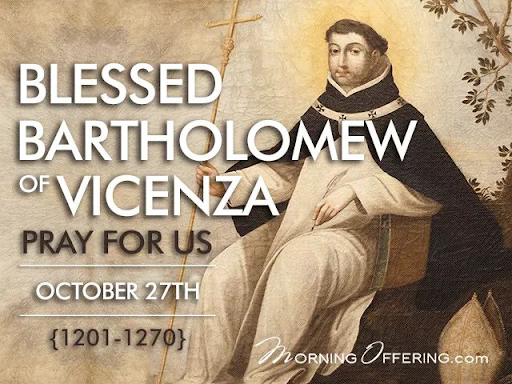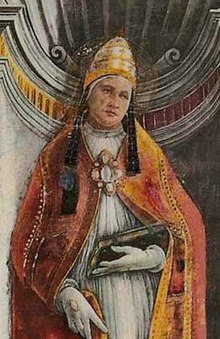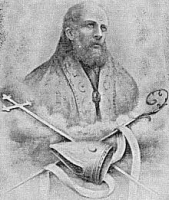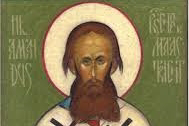Saint Emilina of Boulancourt
Profile
Joined the Cistercian Abbey of Boulancourt at Longeville, France when still very young. Noted for her deep prayer life, fasts, and austere, sometimes severe self-imposed penances such as wearing a pointed chain under her habit, walking barefooted throughout the year and fasting from food and liquids three days a week. Word of her devotion soon spread, and pilgrims came to consult her about holiness and prayer. She had the gift of prophesy, and sometimes prophesied about visitors before they arrived. She never sought honor or glory for herself from her gifts, but dealt with visitors humbly and patiently, always concerned with their conversion and relationship with God.
Born
1115 at France
Died
• 1178 at Longeville, France of natural causes
• a perpetual flame is maintained at her tomb
Blessed Bartholomew of Vicenza
அருளாளர் பர்தொலொமியு
ஆயர்:
பிறப்பு: கி.பி. 1200
விசென்ஸா
இறப்பு: கி.பி. 1271
ஏற்கும் சமயம்:
ரோமன் கத்தோலிக்க திருச்சபை
முக்திபேறு பட்டம்: கி.பி. 1793
திருத்தந்தை ஆறாம் பயஸ்
நினைவுத் திருநாள்: அக்டோபர் 27
“பர்தொலோமியு டி பிரகன்ஸா” (Bartholomew di Braganca) என்றும், “விசென்ஸா
வின் பர்தொலோமியு” (Bartholomew of Vicenza) என்றும் அழைக்கப்படும் இவ்வருளாளர், ஒரு “டொமினிக்கன்” துறவியும் (Dominican Friar) ஆயருமாவார்
வடகிழக்கு இத்தாலியின் “விசென்ஸா” (Vicenza) எனும் நகரின் “பிரகான்சா” உயர்குடியில் (Noble family of di Braganca) பிறந்த இவர், “பதுவை” (Padua) நகரில் கல்வி கற்றார். ஏறத்தாழ தமது இருபது வயதில், புதிதாய் தொடங்கப்பட்ட துறவற சபையான “டொமினிக்கன்” (Dominican Order) சபையின் சீருடைகளை புனிதர் “டொமினிக்கின்” (St. Dominic) கைகளாலேயே பெற்றுக்கொண்டார்.
குருத்துவ அருட்பொழிவு பெற்றதும், விரைவிலேயே தமது சபையின் பல்வேறு தலைமைப் பதவிகளில் பொறுப்பேற்றுப் பணியாற்றினார். தொடக்கத்தில் இவரது வரலாற்றை எழுதிய துறவி “லியாண்டரின்” (Friar Leander) கூற்றின்படி, கி.பி. 1235ம் ஆண்டு, திருத்தந்தை “ஒன்பதாம் கிரகோரியின்” (Pope Gregory IX) ஆட்சிக் காலத்தில், “திருத்தந்தையர் இல்ல அலுவலக இறையியலாளர்” (Theologian of the Pontifical Household) எனும் நிர்வாக அலுவலக தலைமைப் பொறுப்பிலிருந்தார். ஆனால், அதற்கான சான்றுகள் தற்போது கிடையாது.
ஒரு இளம் குருவாக, அவர் இத்தாலியின் அனைத்து நகரங்களிலும் அமைதியும், சமாதானமும் உருவாகும் நோக்கத்தில், ஒரு இராணுவ சபையை நிறுவினார்.
கி.பி. 1248ம் ஆண்டு, “சைப்ரஸ் குடியரசு” (Republic of Cyprus) எனும் தீவிலுள்ள “நெமொநிக்கம்” (Nemonicum) எனும் நகரின் ஆயராக நியமிக்கப்பட்டார். (“நெமொநிக்கம்” எந்த நகர் என்று தற்போது தெரியவில்லை).
பெரும்பாலானோர்க்கு, அத்தகைய ஒரு ஆயர் நியமனம், அவர்களின் பரிசுத்தன்மை, மற்றும் அவர்களின் தலைமை திறன்களுக்கான கௌரவம் அல்லது பாராட்டு, மரியாதை மற்றும் அஞ்சலி ஆகும். ஆனால் இவரைப்பொருத்தவரை, அது திருத்தந்தையரின் எதிரிகளின் குழுக்களால் வற்புறுத்தப்பட்ட ஒரு நாடுகடத்தலேயாகும்.
ஃபிரான்ஸ் நாட்டின் அரசன் “ஒன்பதாம் லூயிஸ்” (King Louis IX of France), “புனித பூமியை” (Holy Land) ஆண்டுவந்த இஸ்லாமியர்களை முற்றுகையிட பயணித்துக்கொண்டிருந்தார்.
(யோர்தான் நதியின் கிழக்கு கரைப்பகுதிகள் (Eastern Bank of the Jordan River) உள்ளிட்ட, யோர்தான் நதி மற்றும் மத்தியதரைக் கடலுக்கு (Mediterranean Sea) இடையிலான ஒரு பகுதி ஆகும். இது யூதர்கள், கிறிஸ்தவர்கள் மற்றும் முஸ்லிம்கள் ஆகியோரால் புனித பூமியாகக் கருதப்படுகிறது.)
அப்போது, இஸ்ரேல் நாட்டின் பழமையான துறைமுக நகரான “ஜோப்பா” (Joppa), லெபனானின் பெரிய நகரங்களில் ஒன்றான “சிடோன்” (Sidon) மற்றும் இஸ்ரேலின் தொழில் துறைமுக நகரான “ஏக்கர்” (Acre) ஆகிய இடங்களில், பர்தொலோமியு “திருத்தந்தையின் தூதராக” (Apostolic legate) அரசன் ஒன்பதாம் லூயிசுடனும், அரசியுடனும் சென்று இணைந்துகொண்டார்.
பல ஆண்டுகளுக்குப்பின் அல்லாது, எப்படியோ, பர்தொலோமியு மீண்டும் விசென்ஸா’வுக்கு மாற்றல் செய்யப்பட்டார். திருத்தந்தையரின் எதிரிகளின் குழுக்களின் எதிர்மறையான உணர்வுகள் இன்னும் வெளிப்படையாக இருந்தபோதிலும், அவர் விடாமுயற்சியுடன், குறிப்பாக அவருடைய பிரசங்கத்தின் மூலம், தனது மறைமாவட்டத்தை மீண்டும் கட்டியெழுப்பவும், ரோமிற்கு மக்கள் விசுவாசத்தை பலப்படுத்தவும் அயராது உழைத்தார்.
இவர் “சைப்ரஸ்” தீவின் ஆயராக பணியாற்றிய காலத்தில், ஃபிரான்ஸ் நாட்டின் அரசன் “ஒன்பதாம் லூயிஸின்” (King Louis IX of France) நட்பு கிட்டியது. அரசன், தூய ஆயருக்கு கிறிஸ்துவின் முள்முடியின் மிச்சமொன்றினை (Relic of Christ’s Crown of Thorns) கொடுத்ததாகவும் கூறப்படுகின்றது.
Also known as
Bartholomew of Braganza
Profile
Joined the Dominicans at Bologna, Italy, receiving the habit from Saint Dominic himself. Noted preacher throughout Lombardy and Emilia in Italy. Bishop of Limassol, Cyprus in 1253. Bishop of Vincenza, Italy in 1255. Worked as a peace maker between warring factions in the region. Friend of King Saint Louis IX of France. Preached at the second translation of the relics of Saint Dominic in 1267.
Born
c.1200 at Vicenza, Italy
Died
1270 in Vicenza, Italy of natural causes
Beatified
11 September 1793 by Pope Pius VI
Saint Abraham the Poor
Also known as
• Abraham the Child
• Abraham the Hermit
Profile
Disciple of Saint Pachomius of Tabenna for 23 years. Lived 17 years as a cave hermit. His nicknames the poor and the child refer to his simple life and simple faith.
Born
at Menuf, Egypt
Died
c.372 of natural causes
Canonized
• Pre-Congregation
• veneration developed first among the Coptic Christians
Saint Elesbaan of Ethiopia
Also known as
• Elesbaan of Axum
• Ella Atsbeha
• Ella Asbeha
• Calam-Negus, Calam, Caleb, Elesbaas, Elesbas, Elesboas, Eleuzoe, Hellestheaeus, Kaleb
Additional Memorial
15 May (Eastern calendar)
Profile
Christian King in Ethiopia in the early 6th century. With the support of Byzantine emperors Justin I and Justinian, he invaded the southern Arabian peninsula where Christian was under attack. Late in life he abdicated his throne to live as a prayerful, penitent hermit and then a monk in Jerusalem.
Died
c.555
Saint Odrian of Waterford
புனிதர் ஓட்ரன்
பிறப்பு: ஆறாம் நூற்றாண்டு
மீத், அயர்லாந்து
இறப்பு: கி.பி. 563
அயோனா, ஸ்காட்லாந்து
ஏற்கும் சமயம்:
ரோமன் கத்தோலிக்க திருச்சபை
மரபுவழி திருச்சபை
ஆங்கிலிக்கன் மற்றும் பிற திருச்சபைகள்
நினைவுத் திருநாள்: அக்டோபர் 27
பாதுகாவல்:
வாட்டர்ஃபோர்ட், அயர்லாந்து, சில்வர்மைன் பங்கு, டிப்பெரேரி
புனிதர் ஓட்ரன் அல்லது ஓரன், பாரம்பரியங்களின்படி, "கொனாளி குல்பன்" (Conall Gulbán) சந்ததியரும், அயோனாவின் புனித கொலம்பா'வின் (Saint Columba) துணையும் ஆவார். அந்தத் தீவில் அடக்கம் செய்யப்பட்ட முதல் கிறிஸ்தவரும் இவரேயாவார்.
வாழ்க்கை:
புனித ஓட்ரன், அயர்லாந்தின் “சில்வர்மைன்ஸ்” (Silvermines) பகுதியில் சுமார் நாற்பது வருடங்கள் வாழ்ந்திருந்தார். கி.பி. 520ம் ஆண்டில் ஒரு ஆலயத்தைக் கட்டினார். ஐரிஷ் பாரம்பரியங்களின்படி, ஓட்ரன் "மீத்" (Meath) என்ற இடத்தின் மடாதிபதியாகவும் இருந்திருக்கிரார். கி.பி. 563ம் ஆண்டில், “அயோனாவின் ஸ்காட்டிஷ்” தீவிற்கு (Scottish island of Iona) “புனிதர் கொலம்பாவுடன்” (Saint Columba) பயணித்த பனிரெண்டு பேரில் இவரும் ஒருவராவார். சென்ற இடத்தில் ஓட்ரன் அங்கேயே மரித்துப்போனார். அங்கேயே அவர் அடக்கமும் செய்யப்பட்டார். ஓட்ரனின் ஆன்மாவானது வான் லோகம் எடுத்துச் செல்வதற்கு முன்னர், அவரது ஆன்மாவுக்காக துர்சக்திகளும் சம்மனசுக்களும் சண்டையிட்டுக்கொண்டதை புனிதர் கொலம்பா நேரில் பார்த்ததாக கூறுகின்றனர்.
ஓட்ரன் மரணம் பற்றிய ஒரு பிரபலமான புராணமும் உள்ளது :
புனிதர் கொலம்பா அயோனாவில் ஒரு ஆலயம் கட்டும் முயற்சியில் இருந்தார். அந்த ஆலயத்தின் அஸ்திவாரத்தில் உயிருள்ள ஒரு மனிதனைப் புதைத்தாலொழிய, ஆலயத்தின் அஸ்திவாரம் நிற்காது என்று தினமும் ஒரு அசரீரி ஒழித்துக்கொண்டே இருந்தது. அதற்கேற்ப, அங்கே பணி செய்யும் தொழிலாளர்கள் தினமும் காலையில் பணிக்கு வருகையில், முதல் நாள் செய்திருந்த பணிகள் சிதைந்து போயிருந்ததை கண்டனர். இதனால், ஓட்ரன் தானாக முன்வந்து, ஆலயத்தின் அஸ்திவாரத்தில் புதையுர ஒப்புக்கொண்டார். அதன்படி புதைக்கப்பட்ட ஓட்ரனின் மேலே கட்டுமான பணி தொடங்கியது. ஒருநாள், புதைக்கப்பட்ட இடத்திலிருந்து தலையைத் தூக்கிய ஓட்ரன், "நீங்களெல்லாம் நினைப்பது போல இங்கே நரகமும் இல்லை; சொர்க்கமும் இல்லை" என்றார். துணுக்குற்ற புனிதர் கொலம்பா, உடனே அவரை மேலே எடுத்து வேறு ஒரு இடத்தில் அடக்கம் செய்தார் என்பர்.
அயோனா மாகாணத்திலுள்ள பழம்பெரும் ஆலயம் ஒன்று புனிதர் ஓட்ரனுக்கு அர்ப்பணிக்கப்பட்டுள்ளது. அதனருகேயுள்ள கல்லறை ஒன்றின் பெயர், ஓட்ரனின் கல்லறை (Reilig Odhráin) ஆகும்.
Also known as
• Odrian of Iona
• Otteran; Odhran; Odran; Oran; Oterano
Profile
Abbot at Meath, Ireland. Early bishop of Waterford, Ireland. Friend of Saint Columba and travelled with him to Scotland to become a monk at Iona Abbey.
Died
c.563 at Iona Abbey, Scotland
Pope Saint Evaristus
Also known as
Aristo, Aristus, Ewaryst
Profile
Son of an Hellenic Jew from Bethlehem. Fifth pope, reigning for eight years, and about whom almost nothing is known. Traditionally considered a martyr, but there is no documentation of the event.
Papal Ascension
c.99
Died
• c.107
• buried in the Vatican near Saint Peter the Apostle
Blessed Salvador Mollar Ventura
Profile
Franciscan Friar Minor. Martyred in the Spanish Civil War.
Born
27 March 1896 in Manises, Valencia, Spain
Died
8 September 1936 in Castellón, Spain
Beatified
11 March 2001 by Pope John Paul II
Blessed Salvador Damián Enguix Garés
Profile
Married layman in the archdiocese of Valencia, Spain. Martyred in the Spanish Civil War.
Born
29 September 1862 in Alzira, Valencia, Spain
Died
27 October 1936 in Alzira, Valencia, Spain
Beatified
11 March 2001 by Pope John Paul II
Saint Abbán of Magh-Armuidhe
Also known as
Eibbán, Moabba
Profile
Son of Cormac, King of Leinster, Ireland. Nephew and disciple of Saint Ibar. Founded churches in Wexford, and monasteries in Magheranoidhe and Kilabbain.
Born
c.570 in Ireland
Died
620 of natural causes
Saint Gaudiosus of Naples
Also known as
• Gaudiosus of Abitinae
• Gaudiosus the African
Profile
Bishop of Abitinae in North Africa. Exiled by the Arian Vandal king Genseric in 440, he fled to Naples, Italy, where he founded a monastery.
Died
c.455 at Naples, Italy of natural causes
Saint Florentius of Trois-Châteaux
Also known as
Florence
Profile
Saint Florentius of Trois-Châteaux was the first historically recorded bishop of the Roman province of Gallia Viennensis. He attended the Council of Epaone (Burgundian Kingdom) in 517, and the synod provincial of Lyon between 517/518 and 523. Very little else is known about his life or episcopacy.
He is commemorated on October 23.
A 15th-century legend identifies Florentius with the blind man who was healed by Jesus in the Gospel of John (John 9:1-12). However, there is no historical evidence to support this claim.
Saint Florentius is the patron saint of the city of Saint-Paul-Trois-Châteaux in France..
Died
3rd century Trois-Châteaux, Burgundy, France
Saint Thraseas of Eumenia
Profile
Bishop of Eumenia, Phrygia (in modern Turkey). Martyred in the persecutions of Marcus Aurelius.
Died
170 at Smyrna (modern Izmir, Turkey)
Saint Colman of Senboth-Fola
Profile
Monk. Spiritual student of Saint Aedan of Ferns. Abbot of Senboth-Fola Abbey near Ferns, Ireland.
Died
c.632
Blessed Goswin of Clairvaux
Profile
Benedictine Cistercian monk at Clairvaux Abbey, and then at Cheminon, France.
Died
1203 of natural causes
Saint Namatius of Clermont
Also known as
Namace, Namazio
Profile
Saint Namatius of Clermont was a bishop of Clermont in Auvergne, France, in the 5th century. He is recognized as a saint by the Catholic Church and his feast day is celebrated on October 27th.
Namatius succeeded Saint Rusticus as bishop of Clermont in 446. He is best known for founding the Clermont Cathedral, which was dedicated to Saints Vital and Agricola. The cathedral was a large and impressive building, with a nave and two aisles, a round apse, and forty-two windows. It was destroyed by Pepin the Short in 760, but was rebuilt and later destroyed again by the Normans in 915. The current Clermont Cathedral was built on the same site in the 13th century.
Namatius was also a zealous defender of the Catholic faith. He attended the Council of Arles in 443 and the Council of Orange in 441. He also wrote several letters to other bishops on theological matters.
Namatius died in 462 and was buried in the Clermont Cathedral. He was venerated as a saint shortly after his death.
In addition to his work as bishop and founder of the Clermont Cathedral, Namatius is also known for his generosity to the poor and his hospitality to strangers. He is often depicted in art as a benevolent old man with a long white beard.
Namatius is a patron saint of the city of Clermont-Ferrand and of the Diocese of Clermont. He is also invoked by those who are building or renovating churches.Died
c.462 of natural causes
Saint Desiderius of Auxerre
Saint Desiderius of Auxerre (died 621) was bishop of Auxerre, in France, from 614 to 621. He was from Aquitaine, and is mentioned in the Gesta pontificum Autissiodorensium, as well as the Chronicle of Fredegar. He is known for his large bequest to his church, St. Stephen's, of 300 pounds of rich liturgical vessels. These objects were stolen in 1567. His wealth probably came from a noble background; he is thought to have been a kinsman of Queen Brunhild. He is a Catholic saint, whose feast day is 19 October.
Desiderius was born in the early 7th century in Aquitaine, a region in the southwest of France. He came from a noble family and was well-educated. He was ordained a priest and served in the diocese of Vienne, France. In 614, he was elected bishop of Auxerre.
As bishop, Desiderius was known for his piety and generosity. He was a strong supporter of the Catholic faith and worked to promote unity and peace in his diocese. He was also a patron of the arts and culture.
Desiderius died in 621 and was buried in the cathedral of Auxerre. He was venerated as a saint shortly after his death.
Desiderius is a patron saint of the city of Auxerre and of the Diocese of Auxerre. He is also invoked by those who seek help in finding lost or stolen objects.
Saint Capitolina
Saint Capitolina was a martyred woman of Cappadocia, with her handmaid, Erotheis. They died in the persecutions conducted by Emperor Diocletian.
Capitolina was a noble and wealthy lady, but she had no regard for riches. Therefore, she divided all of her property among the poor, and freed her slaves.
When she was arrested as a Christian and appeared before the magistrate of Cappadocia, she confessed her faith in Christ. He ordered her to be thrown into prison, and she was beheaded the next day.
Erotheis, Capitolina's servant, was also a Christian. When she saw her mistress being led to execution, she picked up some stones and threw them at the magistrate. He was outraged, and ordered his guards to beat her mercilessly. However, by the grace of Christ, she remained unharmed.
The magistrate then ordered Erotheis to be beheaded. In this manner, both Capitolina and Erotheis died for their faith in Christ.
Saint Capitolina and Saint Erotheis are commemorated on October 27th in the Orthodox Church and on October 26th in the Catholic Church.
Saint Erotheides
Profile
Saint Erotheides (Greek: Άγιος Ερωθηίδης) was a child martyr of the early Christian church. He is said to have been born in Athens, Greece, around the year 130 AD. During the reign of the Roman emperor Hadrian, Erotheides and his mother were arrested for their Christian faith. His mother was beheaded, but Erotheides was too young to be executed, so he was thrown into prison.
In prison, Erotheides was subjected to many hardships, but he remained faithful to his faith. He was eventually beaten to death by the prison guards. Erotheides is said to have been only 10 years old when he died.
The veneration of Saint Erotheides began shortly after his death. His body was buried in Athens, and a church was built over his grave. Erotheides is considered to be one of the youngest Christian martyrs.Died
304 in Cappadocia
Balsamia
Saint Balsamia was a 3rd-century Christian saint who was born in the city of Hierapolis, in what is now Turkey. She was a disciple of the local bishop, Saint Babylon, and at a young age she stood out for her wisdom and knowledge of the Scriptures.
Balsamia was executed during the religious persecutions. According to legend, the bishop, Babylon, who was also awaiting execution, gave the cross to Balsamia and asked her to carry it during the execution. Balsamia did so and died a heroic death.
Balsamia is venerated as a saint by the Christian Church. Her feast day is celebrated on April 23rd. Saint Balsamia's feast day is also celebrated on October 27th. This is in addition to her feast day on April 23rd.
Life
Balsamia was born in the 3rd century in the city of Hierapolis, in what is now Turkey. The city was an important Christian center at the time, and many bishops and saints lived there.
At a young age, Balsamia stood out for her wisdom and knowledge of the Scriptures. She became a disciple of the local bishop, Saint Babylon, and soon became one of his closest collaborators.
Execution
In the 3rd century, Emperor Diocletian launched severe persecutions against the Christians. In Hierapolis, many Christians were arrested and executed.
Balsamia was also arrested and sentenced to death. According to legend, the bishop, Babylon, who was also awaiting execution, gave the cross to Balsamia and asked her to carry it during the execution. Balsamia did so and died a heroic death.
Veneration
Balsamia is venerated as a saint by the Christian Church. Her feast day is celebrated on April 23rd.
Peter de Pazzis
Saint Peter de Pazzis (1230-1326) was an Italian friar who was the founder of the Capuchin order.
Peter de Pazzis was born in 1230 near Florence, to a wealthy family. As a young man, he joined the Franciscan Order and served as a friar in Assisi. In 1260, in a vision, God instructed him to found a new religious order based on the principles of poverty, chastity, and humility.
Peter de Pazzis founded the Capuchin Order in 1261. The members of the order lived simple, poor lives and dedicated themselves to serving the poor and the sick. Peter de Pazzis himself set an example in poverty and humility, and was often seen serving among the poor and the sick.
Peter de Pazzis died in 1326 and was canonized in 1623. The Capuchin Order is now one of the largest religious orders in the world, with a presence in over 120 countries.
Life
Peter de Pazzis was born in 1230 near Florence, to a wealthy family. As a young man, he joined the Franciscan Order and served as a friar in Assisi. In 1260, in a vision, God instructed him to found a new religious order based on the principles of poverty, chastity, and humility.
Founding of the Capuchin Order
Peter de Pazzis founded the Capuchin Order in 1261. The members of the order lived simple, poor lives and dedicated themselves to serving the poor and the sick. Peter de Pazzis himself set an example in poverty and humility, and was often seen serving among the poor and the sick.
Life and work of Peter de Pazzis
Peter de Pazzis lived his entire life following the principles of poverty and humility. With the founding of the Capuchin Order, he showed new ways for religious life. Peter de Pazzis died in 1326 and was canonized in 1623. The Capuchin Order is now one of the largest religious orders in the world, with a presence in over 120 countries.
Veneration
Peter de Pazzis is held in great esteem by members of the Capuchin Order. He bears the title of "Father General" in the order. Peter de Pazzis is venerated as a model of poverty and humility, and is often turned to in prayer.
Abilities
Peter de Pazzis has been associated with many miracles. According to legend, he healed the sick and freed people from evil spirits.
In the arts
Peter de Pazzis has been depicted in many works of art. The most famous image, painted in the 15th century, shows Peter de Pazzis holding the cross in his hand, and the co-founders of the Capuchin order at his side.
Literature
Many books and studies have been published on the life and work of Peter de Pazzis. The most famous biography was written in the 14th century and bears the title "Vita di san Francesco di Paola".
Theodule of Sion
Théodule of Sion, also known as Theodore of Octodurum, was the first known bishop of Octodurum, Alpes Poeninae province (present-day Martigny, Valais, Switzerland). He lived in the 4th century and is venerated as a saint in the Catholic Church and the Orthodox Church. His feast day is August 16th.
Théodule is said to have been a very holy man, and he was known for his great charity and his many miracles. He is credited with converting many people to Christianity, and he is also said to have founded the first Christian church in Sion.
One of the most famous legends about Théodule is that he forced the devil to carry a church bell across the Theodul Pass. The devil was carrying the bell to a church in Italy, but Théodule stopped him and told him to carry it to Sion instead. The devil refused, but Théodule threatened to exorcise him if he did not obey. The devil eventually relented and carried the bell to Sion.
Théodule of Sion is the patron saint of the canton of Valais in Switzerland and of the Walser people. He is also a patron saint of travelers and hikers.





















